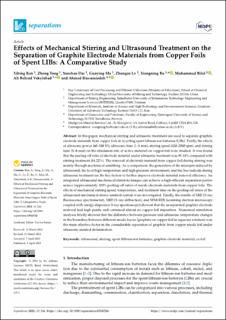| dc.contributor.author | Ren, Xibing | |
| dc.contributor.author | Tong, Zheng | |
| dc.contributor.author | Dai, Yanshan | |
| dc.contributor.author | Ma, Guoying | |
| dc.contributor.author | Lv, Zhongze | |
| dc.contributor.author | Bu, Xiangning | |
| dc.contributor.author | Bilal, Muhammad | |
| dc.contributor.author | Vakylabad, Ali Behrad | |
| dc.contributor.author | Hassanzadeh, Ahmad | |
| dc.date.accessioned | 2023-11-13T13:37:44Z | |
| dc.date.available | 2023-11-13T13:37:44Z | |
| dc.date.created | 2023-05-15T14:28:38Z | |
| dc.date.issued | 2023 | |
| dc.identifier.citation | Separations. 2023, 10 (4), . | en_US |
| dc.identifier.issn | 2297-8739 | |
| dc.identifier.uri | https://hdl.handle.net/11250/3102211 | |
| dc.description.abstract | In this paper, mechanical stirring and ultrasonic treatment are used to separate graphite electrode materials from copper foils in recycling spent lithium-ion batteries (LIBs). Firstly, the effects of ultrasonic power (60–180 W), ultrasonic time (1–8 min), stirring speed (420–2000 rpm), and stirring time (1–8 min) on the abscission rate of active material on copper foil were studied. It was found that the peeling-off ratio of electrode material under ultrasonic treatment was 91.34% compared with stirring treatment (84.22%). The removal of electrode material from copper foil during stirring was mainly through mechanical scrubbing. As a comparison, the generation of the microjets induced by ultrasound, the local high-temperature and high-pressure environment, and the free radicals during ultrasonic treatment are the key factors to further improve electrode material removal efficiency. An integrated ultrasound-mechanical stirrer technique can achieve a high-efficient separation performance (approximately 100% peeling-off ratio) of anode electrode materials from copper foils. The effects of mechanical stirring speed, temperature, and treatment time on the peeling-off ratios of the ultrasound-mechanical stirrer-assisted system were investigated. Finally, the results of XRF (X-ray fluorescence spectrometer), XRD (X-ray diffraction), and SEM-EDS (scanning electron microscopy coupled with energy dispersive X-ray spectroscopy) showed that the as-separated graphite electrode material had high purity and contained almost no copper foil impurities. Numerical simulation analyses briefly showed that the difference between pressure and ultrasonic temperature changes in the boundary between different anode layers (graphite on copper foil in aqueous solution) was the main effective factor in the considerable separation of graphite from copper anode foil under ultrasonic-assisted delamination. | en_US |
| dc.language.iso | eng | en_US |
| dc.publisher | MDPI | en_US |
| dc.rights | Navngivelse 4.0 Internasjonal | * |
| dc.rights.uri | http://creativecommons.org/licenses/by/4.0/deed.no | * |
| dc.title | Effects of Mechanical Stirring and Ultrasound Treatment on the Separation of Graphite Electrode Materials from Copper Foils of Spent LIBs: A Comparative Study | en_US |
| dc.title.alternative | Effects of Mechanical Stirring and Ultrasound Treatment on the Separation of Graphite Electrode Materials from Copper Foils of Spent LIBs: A Comparative Study | en_US |
| dc.type | Peer reviewed | en_US |
| dc.type | Journal article | en_US |
| dc.description.version | publishedVersion | en_US |
| dc.source.pagenumber | 0 | en_US |
| dc.source.volume | 10 | en_US |
| dc.source.journal | Separations | en_US |
| dc.source.issue | 4 | en_US |
| dc.identifier.doi | 10.3390/separations10040246 | |
| dc.identifier.cristin | 2147614 | |
| cristin.ispublished | true | |
| cristin.fulltext | original | |
| cristin.qualitycode | 1 | |

